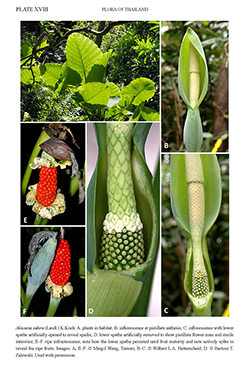e-Flora of Thailand
Volume 11 > Part 2 > Year 2012 > Page 128 > Araceae > Alocasia
9. Alocasia odora (Lindl.) K.Koch
Index Seminum (B) 1854(App.): 2. 1854; Schott, Syn. Aroid: 45–46. 1856; Prodr. Syst. Aroid.: 148–149. 1860 (sub. A. commutata); Engl. in A.DC. & C.DC., Monogr. Phan. 2: 503–504. 1879; Krause in Engl., Pflanzenr. IV, 23E (Heft 71): 90. 1920; Gagnep. in Lecomte (ed.), Fl. Indo-Chine 6: 1147–1148. 1942; Boyce, Thai Forest Bull., Bot. 36: 15. 2008.— Caladium odorum Lindl., Bot. Reg. 8: t. 641. 1822.— Arum odorum (Lindl.) Roxb., Fl. Ind. ed. 1832, 3: 499. 1832.— Colocasia odora (Lindl.) Brongn., Nouv. Ann. Mus. Hist. Nat. 3: 145. 1834. Plate XVII.
Accepted Name : This is currently accepted.
Synonyms & Citations :
Description : Massive, pachycaul, evergreen herb to 2.5 m with slightly milky latex. Stem erect to decumbent, with short stolons terminating in tubercles arising from the base. Leaves several to rather many together, clustered at the tips of stems of larger plants; petiole to 1.5 m long; petiolar sheath membranous; leaf blade peltate, cordate-sagittate or cordate-ovate, to 130 by 100 cm, apex short acuminate, base margins undulate; primary lateral veins 9–12 on each side; interprimary veins forming well-defined interprimary collecting veins. Inflorescences 2–3 together, subtended by membranous cataphylls, powerfully fruity-fragrant at anthesis; peduncle stout, ca 35 cm long, exceeding the cataphylls at anthesis, medium dull green; spathe ca 13–25 cm long, constricted about ⅙ of the way from the base; lower part ovoid, grey-green glaucous; spathe limb broadly oblong-lanceolate, 10–30 by 4–8 cm, remaining erect and hooded at anthesis, submembranous, exterior grey-green, conspicuously glaucous, interior greenish white; spadix shorter than the spathe, shortly stipitate. Pistillate flower zone 1–2 by ca 1.5 cm; ovaries medium green, ca 2 mm diam., almost perpendicular to the spadix axis; stigma almost sessile, very obscurely 3-lobed, very pale green, coated in viscous white secretion at pistillate anthesis; sterile interstice tapering gradually away from the pistillate zone, equalling the staminate zone, ivory, very slightly narrowed corresponding to the spathe constriction; synandrodia composed of rhombo-hexagonal stamens, ca 2.5 mm diam., the lowermost enlarged and regularly annulate; staminate flower zone cylindrical, ca 3–5 by ca 2 cm, whitish; synandria rhombo-hexagonal, convex-topped owing to cap-forming synconnective, ca 1.5 mm diam.; appendix elongate-conical, 3–5.5 by 1–2 cm, equalling length of the spadix, markedly thicker than the staminate zone at the base, then gradually tapering, white. Fruiting spathe ca 6 cm long, glaucous to almost pruinose; fruits globose, ca 1 cm diam., ripening scarlet.
Thailand : SOUTH-WESTERN: Kanchanaburi; PENINSULAR: Phuket.
Distribution : India (Assam) SW China, through Myanmar (type), Laos, and south as far as SW Cambodia and east to Japan (Ryukyus).
Ecology : Primary and secondary tropical rain forests, bamboo-thickets, riverbanks, swamps, sometimes on limestone; below 1,700 m alt.
Vernacular : Mo (เมาะ)(Peninsular).
Uses: In China the rhizomes are used for the treatment of stomachache and abdominal pain, cholera and hernia; externally to treat abscesses, snake or insect bites.
Notes: Alocasia odora is a widespread and common species in the wild but, as with most of the large Araceae, is very poorly represented in herbaria owing to the difficulty of collecting and preparing an adequate herbarium specimen.
Alocasia odora is often confused with A. macrorrhizos although as adult plants they are readily distinguished: A. odora has leaf blades weakly peltate in the sinus (vs naked), and proportionately much shorter spadix appendix. Further, A. macrorrhizos never produces stolons from the base of the stems.
Confusion with Alocasia fornicata, which is much rarer in Thailand, is also possible. The latter has a proportionately stouter pistillate flower zone with ascending pistils and much more conspicuously 3-lobed stigmas. Furthermore, the sterile zone of A. odora gradually tapers away from the pistillate zone, with the lowermost synandrodia annulate. By comparison, the sterile zone of A. fornicata abruptly narrows and has highly irregular synandrodia.

